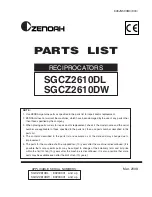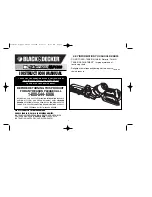
IMPORTANT SAFETY WARNINGS
33
39. Make sure that the blade shaft, flanges or bolts are not damaged, as this
could cause blade breakage.
40. Make sure that the rotary table is properly secured so it will not move during
operation.
41. For your safety, remove the chips, small pieces, etc. from the tabletop
before operation.
42. To avoid cutting nails, inspect workpiece and remove all nails before
operation.
43. Make sure the shaft lock is released before the switch is turned on.
44. Make sure that the blade does not contact the rotary table in the lowest
position.
45. Hold the handle firmly. Be aware that the saw moves up or down slightly
during start-up and stopping.
46. Make sure the blade is not contacting the workpiece before the switch is
turned on.
47. Before using the tool on an actual workpiece, let it run for a while. Watch
for vibration or wobbling that could indicate poor installation or a poorly
balanced blade.
48. Wait until the blade attains full speed before cutting.
49. Stop operation immediately if you notice anything abnormal.
50. Do not attempt to lock the trigger in the on position.
51. Be alert at all times, especially during repetitive, monotonous operations.
Do not be lulled into a false sense of security. A single moment of
inattention can provoke serious injury.
52. Always use accessories recommended in this manual. Use of improper
accessories such as abrasive wheels may cause an injury.
53. Do not use the saw to cut anything other than wood.
54. Connect mitre saws to a dust collecting device when sawing.
55. Take care when slotting.
56. Replace the kerf board when worn.
57. Do not use saw blades manufactured from high speed steel.
58. Some dust created from operation contains chemicals known to cause
many serious diseases such as cancer. Some examples of these chemicals
are:
• Lead from lead-based-painted material and;
• Arsenic and chromium from chemically-treated lumber.
Your risk from these exposures varies, depending on how often you do
this type of work. To reduce your exposure to these chemicals: work in a
well ventilated area and work with approved safety equipment, such as
dust masks that are specially designed to filter out microscopic particles.
59. To reduce the emitted noise, always be sure that the blade is sharp and
clean.
60. The operator is adequately trained in the use, adjustment and operation
of the machine.
61. Use correctly sharpened saw blades. Observe the maximum speed marked
on the saw blade.
62. Refrain from removing any cut-offs or other parts of the workpiece from
the cutting area while the tool is running and the saw head is not in the
rest position.
63. Wear gloves for handling saw blades (saw blades shall be carried in a
holder wherever practicable) and rough material.
64. Do not replace laser with one of a different type.
65. Use the ear protection during cutting to avoid listening injury.
ENGLISH














































